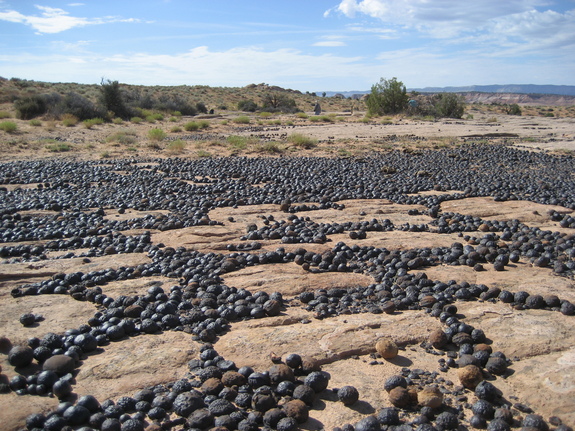 At www.livescience.com/39117-navajo-sandstone-dunes-jurassic-earthquake.html … Utah has some spectacular geology – not least the remarkable sandstone formation above, found in the Zion National Park. These are cliffs of sand and are thought to have originated as sand dunes a very long time ago – in the era of the dinosaurs (the Jurassic). The sandstone, or relic dunes, contain cylindrical pipes due to liquified sand (water and sand, or quicksand) spouting up through the sand dunes and pumping it to the surface. The funny bit is that sand dunes are associated with deserts – and very dry environments. So what is wet sand doing gushing out of the dunes?
At www.livescience.com/39117-navajo-sandstone-dunes-jurassic-earthquake.html … Utah has some spectacular geology – not least the remarkable sandstone formation above, found in the Zion National Park. These are cliffs of sand and are thought to have originated as sand dunes a very long time ago – in the era of the dinosaurs (the Jurassic). The sandstone, or relic dunes, contain cylindrical pipes due to liquified sand (water and sand, or quicksand) spouting up through the sand dunes and pumping it to the surface. The funny bit is that sand dunes are associated with deserts – and very dry environments. So what is wet sand doing gushing out of the dunes?
Sand pipes are also known as sand blow-outs and in general are attributed to earthquakes. However, the source os such an earthquake is a mystery, we are told – but they know it all happened very quickly as the geology is telling them that is so. Liquefaction features such as sand blow-outs are compared to the 2011 Christchurch earthquake event in New Zealand. Christchurch sits on geology that contains a lot of sand and the earthquake created sand pipe like features. It is unclear if it involved wet sand and if it didn't the structures would be somewhat dissimilar (as well as similar). One answer to the mystery might be at http://malagabay.wordpress.com/2014/03/24/the-eye-of-nebraska/
 At www.livescience.com/47936-how-moqui-marbles-form.html … hundreds of round iron coated stones litter the ground on the Navajo sandstone formation. They are concretions, sandstone balls concreted by a hard shell of iron oxide minerals. Known as moqui marbles, there are acres of them spread around the surface of Utah and Arizona. Look alike objects can be found on Mars – the so called blueberries. The Moqui Marbles are much younger than the Navajo sandstone itself – and is therefore separated in time if not in place from the relic sand dunes.
At www.livescience.com/47936-how-moqui-marbles-form.html … hundreds of round iron coated stones litter the ground on the Navajo sandstone formation. They are concretions, sandstone balls concreted by a hard shell of iron oxide minerals. Known as moqui marbles, there are acres of them spread around the surface of Utah and Arizona. Look alike objects can be found on Mars – the so called blueberries. The Moqui Marbles are much younger than the Navajo sandstone itself – and is therefore separated in time if not in place from the relic sand dunes.
